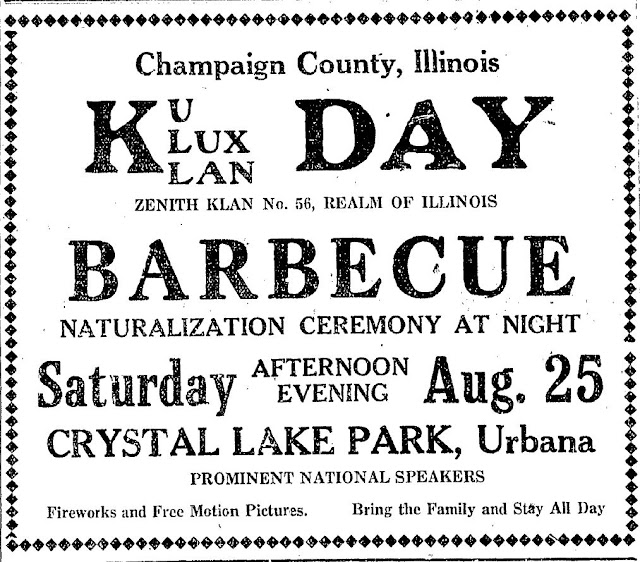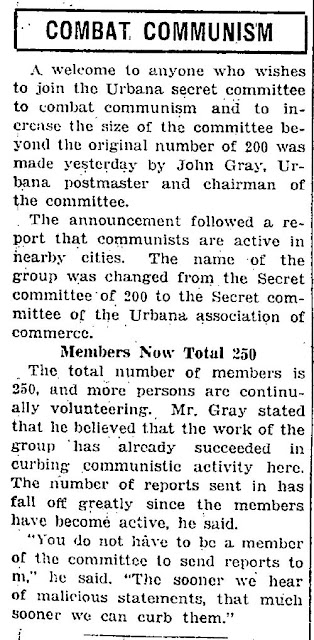 |
| Clipping from the 2/13/1925 edition of "The Fiery Cross." |
The first open meeting of the local Klan in Champaign-Urbana was held at the Illinois Theater on 1/30/1923. The Urbana Daily Courier had an announcement and coverage of the event on 1/30 and 1/31/1923 along with the Champaign News-Gazette:
A modern reader may find the Klan's description of itself as a non-violent organization for decent Christians to sound absurd, but it was a big part of the public image of the second Klan at the time. In public they would assure people that they "have no enmity for the Jew, the negro, or the Catholic" as compatible in their belief of white supremacy. This was typical of other Klan marketing throughout the North. An example from a Klan advertisement in an 10/19/1922 Springfield, Oregon paper makes almost identical claims, e.g. "The Ku Klux Klan is not anti-negro, anti-Jew, anti-Japanese, or anti-Catholic. It believes in justice to all, including the white man." Click to enlarge:
By April the local Klan was putting on demonstrations with massive 40 foot tall cross burnings. the News-Gazette noted that local police were alerted, but had no interest in interfering. From the 4/10/1923 News-Gazette:
A couple days later the News-Gazette and Daily Illini would report that the campus Klan was changing its name and reiterating that it was not affiliated with the national organization that had since formed a local Klavern in Urbana. Both note that decision had been made provisionally the month before, though the Daily Illini explained that it was finalized the night before the announcement in the 4/12/1923 papers:
A few days later the Daily Illini would report a cross burning on campus. From the 4/15/1923 paper:
A few days after that, on 4/19/1923, the News-Gazette was reporting a third local cross burning was reported in Urbana. The large cross was again described as 40 feet tall and 20 feet wide. The demonstration was preceded by "air bombs" to attract attention beforehand. It also mentioned the smaller campus cross burning earlier.
April 1923 is also the month that the prohibitionist Klan raider Glenn Young started working with local law enforcement on liquor raids. From the 4/24/1923 Courier:
At this point in his career Young was known more for being a five time killer federal agent. He would become infamous after his raiding days in Champaign County in what would become known as "Bloody Williamson" County where he built a Klan army (check out the book of the same name under "Books" in our Sources page). In later speeches and in his post-humous biography the cooperation local Champaign County law enforcement had with the Klan was noted:
Then Sheriff, and later Urbana Mayor, John Gray would openly praise the notorious Klan raider and attended his funeral as a strong supporter of his work. Urbana Chief of Police Roy Innes would also attend the funeral. Both were described as close personal friends since their work together in 1923. There will be a future post with more on local raids in Champaign County with Young, his raiders, and local law enforcement in 1923.
The 5/24/1923 Villa Grove News reported that "number of officers from Champaign" and other Illinois Klans were part of the ceremonies and presented the Klan charters to the Klan organizations there in Villa Grove and in Tuscola. Both towns are part of Douglas County directly South of Champaign. Villa Grove, being right on the County Line played a role in Champaign Klan organization and vice versa. Two Villa Grove ministers would play an oversized role in early local Klan activities: O. K. Doney and J. F. Hollingsworth.
Around this time in area papers, advertisements for "The Fiery Cross" and other Klan materials began popping up. Here are couple examples from the 6/27/1923 Mattoon Journal Gazette and Rev. McMahan and the 5/26/1923 Courier locally:
At the end of May, the local Klan, the Veterans of Foreign Wars, the Boy Scouts, and members of the Grand Army of the Republic dedicated a marker to Ellis G. Stillwell who died in World War I. The Klan participated in full regalia with the exception of Klan minister O. K. Doney. The Klan marched in a "cross formation" and placed a "fiery cross" arrangement of flowers on the marker as part of the dedication. From the 5/30/1923 News-Gazette:
On 7/22/1923 the local Klan announced a massive local Klan gathering, promising unbelievable large numbers for a "Champaign County Ku Klux Klan day." The article notes the local chapter is called the Zenith Klan No. 56 and that the catering would be done by local grocery store owner and Sidney resident J. J. Reynolds. Reynolds would later be openly known as the "Exalted Cyclops" or leader of the County organization.
While the Courier was reasonably skeptical of the estimated attendance, thousands of attendees was not out of the question. The Day before the Courier had reported that 3,000 had gathered in the nearby small town of Homer after parades through Ogden and St. Joseph:
Advertisements for the Champaign County "Klan Day" gave details of the planned activities. From the 8/22/1923 Courier:
The 8/24/1923 News-Gazette noted that Rev. McMahan would again be a featured speaker at this event as well:
The Courier had coverage of the parades and early activities of the day along with announcements of the activities planned for the evening in the 8/25/1923 paper. Both the News-Gazette and Courier coverage noted that klansmen were helping direct traffic and standing on prominent corners throughout town, but the Courier noted at least some citizen discontent with that situation.
The News-Gazette included a picture of the giant U.S. flag and crowds at the Crystal Lake Park event on 8/26/1923:
As was typical for many newspapers of the second Klan era, reporters and editors started off playing along with the "mystery" of who was or wasn't in the local Klan. This did not hold up over time, especially as the Klan became more controversial in the wake of Klan violence and corruption across the nation and in Southern Illinois especially.
Around this same time there was a "debate" between local Klan minister O. K. Doney and a Catholic critic of the Klan in Rantoul. As was common for Klan debates of this time, the press coverage included a pro-Klan resolution to be debated, gave publicity to the Klan, and helped amplify their message on a local platform. The details and arguments of the debate itself often unreported and left to the attendees to hear or remember. This played out identically in Mattoon during their Labor Day "debate." Announcement in the 8/23/1923 Courier:
The Rantoul Weekly Press coverage on 8/30/1923 played out similarly. The Klan position is presented and amplified, but there is no coverage of the debate itself:
September saw a massive Klan parade starting at the Urbana High School, going through town, and out to Mahomet. Thousands participated, hundreds initiated into the order again. The 9/29/1923 Courier continued to play into the "mystery" of who was involved:
October coverage in the Courier suggested that Klan meetings and initiations in Champaign and Urbana had become fairly regular occurrences. On 10/16/2023 the Courier noted recent St. Joseph attendees at a Champaign meeting. On 10/27/1923 it reported 300 new initiates at a recent meeting, 300 new initiates expected at an upcoming meeting, and an average of 112 new Klan initiates every week:
There was a flurry of Klan activity reported in small towns throughout the area in the local coverage. Attendees from one town were noted as attending events in other towns. Parades in Mahomet, a girl's quartet singing Klan songs from St. Joseph, orchestras from Sidney, and visitors from all over. Here's one example from the 10/3/1923 Courier about an event in Rantoul:
In October it was also reported that the Klan was buying the Illinois Theater which had become a primary venue for its activities in Twin Cities. From the 10/20/1923 Courier:
The Mahomet Sucker State newspaper would have more details on the Klan's purchase of the Illinois Theater, their use of the "Zenith Amusement Company" after the name of the local Zenith Klan No. 56 itself. It promised "respectable" and "clean" entertainment. They hinted at the Klan involvement through unsubtle alliteration (an odd part of the practice of not saying the open secret in many Northern towns): e.g. "Klean-Klever-Komedy." A separate blurb on a separate page announced that the Klan would be using it as its meeting place, as if it were unrelated to the new ownership. From the 11/8/1923 weekly Sucker State:
The Zenith Amusement Company was owned by J. J. Reynolds, who it would soon be reported was also the "Exalted Cyclops" of the Zenith Klan No. 56 of Champaign County. The theater and the Reynolds family itself publicly celebrated and dedicated both the new headquarters and a wedding of his daughter Helen Reynolds with a two day event including the then national leader of the Ku Klux Klan, Imperial Wizard Hiram Evans. From the 11/15, 11/20, 11/24/1923 Urbana Daily Courier:
From the bride's wedding book, as discovered by David Early in his research on the local Klan: "The ceremony was performed in the new home of Zenith Klan No. 56 Realm of Illinois KKK. The Klavern was arranged with three monster K's in rear, a large cross on either side, lighted, and the altar duly prepared in center and a semi-circle of Klansman and Klanswomen in full regalia as a background for the wedding. The contracting parties, in full regalia, stood in front of the altar, facing the east. The curtain raised at 8:25 and Rev. McMahon offered a beautiful opening prayer, then joined the ranks of Klansmen two paces to rear of Groom; O.K. Doney then bound Helen (Reynolds) and Harry (Lee) together by a beautiful Klan ceremony prayer. Prayer: McMahon. Bride & Groom introduced to Klansmen & Klanswomen, & received sign of greeting; introduced to throng of 1500 - hearty cheer of greeting...."
A brief overview of the Klan's ownership of the Illinois Theater is included in our Exalted Cyclops page. A more comprehensive look at the Illinois Theater's entire history is available at the Champaign-Urbana Theater History website by Perry C. Morris. It would unfortunately spend its final years as the headquarters for the C-U Klan.
Next post in this series: The Imperial Wizard Comes to Town







































No comments:
Post a Comment